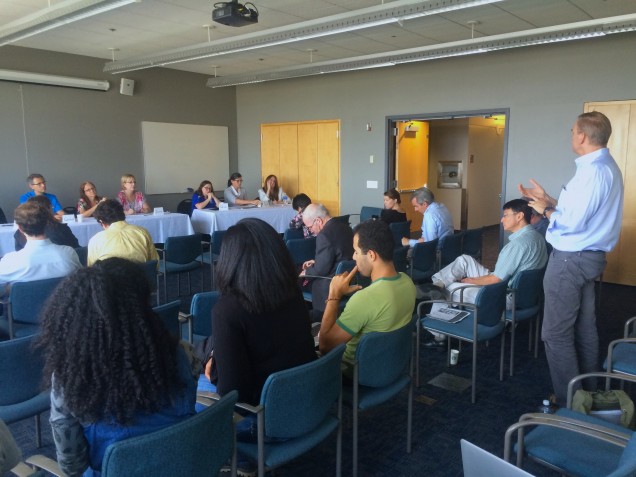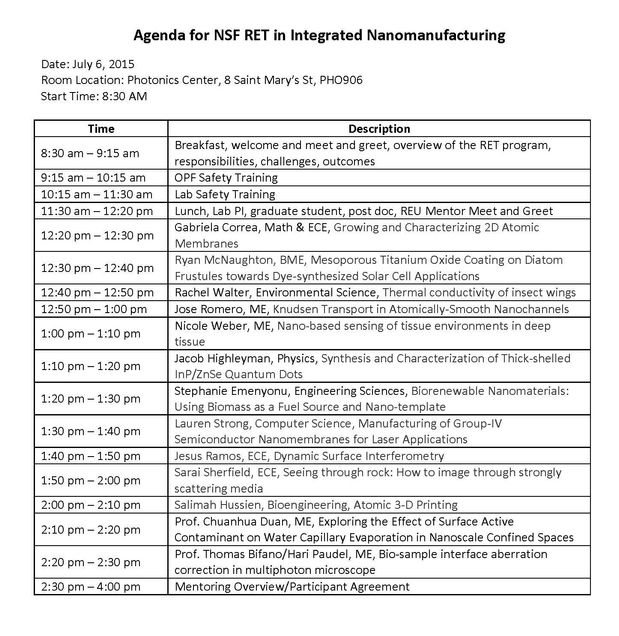2015 News & Updates
Closing Certificate Ceremony for NSF RET INM – August 12, 2105
As a sweet ending to our first year, the REU and RET participants were led to a final meeting where instead of learning more before the end of the program, they were met with an ice cream sundae social and a certificate ceremony. Each teacher participant was presented with a participation certificate and a PDP certificate and took final pictures with their labs. It was a great first summer and we look forward to recruiting for next year!
Enjoy this photo gallery as a final slideshow of our REU/RET summer:
Certificates and Lab Photos
A final gallery of lab photos from the summer
Final Poster Presentation – Wrapping Up the Summer, August 7, 2015.
This morning the participants of REU and RET presented the projects they have been working on in lab all summer. Set up on high-tech, LED monitors, each poster was detailed and organized, presenting graphs, videos and other visuals to allow the audience a clear understanding of what went on in Photonics these past ten weeks. Many REU/RET pairs presented their work together, like Jake Highleyman and Ryan Grams, helping each other explain their processes and research. Others, like Stephanie Emenyonu and Eric Jackson, presented separate posters to better explain their different findings. Although their goal was the same, each attempted to reach that goal with a different method. One turned out to be better than the other as the results were more clear, and as they presented their different methods, they also explained how they worked off of each other and what that may lead to with future research. Overall, the turnout at the poster session was great and each participant was given a moment to explain and be recognized for their hard work this summer. After the presentation, the REU participants presented Helen Fawcett, the co-PI of the REU program, with a thoughtful gift to say “thank you” for all of her hard work. This summer could not have been possible without her and Prof. Xin Zhang, along with Prof. Bennett Goldberg, co-PI of the RET program.
Brown Bag Seminar – Introduction to Societal Engineer® ARROWS and STEM outreach, August 5, 2015, Gretchen Fougere, Prof. Joyce Wong and Prof. Kathryn Spilios
Today, our REU and RET participants learned first hand of the STEM initiatives at Boston University. We were fortunate to have Gretchen Fougere, Associate Dean for Outreach & Diversity at the College of Engineering discuss introduce the College of Engineering’s Societal Engineer® and the programs that she oversees with undergraduates in the College of Engineering who integrate curriculum supplemental material to classrooms locally from from their hometowns (Inspiration Ambassadors). The goal is to help students in high school and middle school understand what engineers do and help supplement what is being taught in the curriculum. In addition, she spoke of the STEEP program where engineering students exit after five years with an undergraduate degree in engineering and a master’s degree in teaching. Prof. Joyce Wong, who is a Professor of Biomedical and Materials Science and Engineering as well as Director of a new effort aimed at advancing women in these critical fields at BU, ARROWS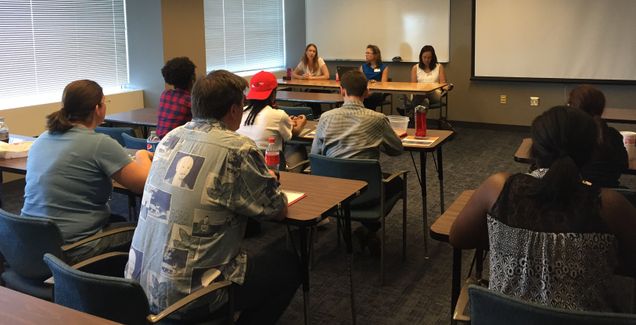 (Advance, Recruit, Retain and Organize Women in STEM) provided some enlightening information about famous women who played critical roles behind the scenes on many important operations in the U.S. Specifically she mentioned Katherine Johnson, an African American female mathematician, who contributed to the calculations for NASA, most notably for the Apollo mission for the trajectory for the space flight of Alan Shepard. Prof. Kathryn Spilios, who works directly with Bennett Goldberg, Director of STEM Initiatives at Boston University, provided an overview of the mentoring and training that is being developed and implemented for faculty, graduate students and post doctoral researchers, educating them in effective communication to support peer learning and facilitate group discussions. After this in depth and educational brown bag, many of our teachers are excited to learn more about how their schools can reach out and become part of the diversity and STEM opportunities at Boston University.
(Advance, Recruit, Retain and Organize Women in STEM) provided some enlightening information about famous women who played critical roles behind the scenes on many important operations in the U.S. Specifically she mentioned Katherine Johnson, an African American female mathematician, who contributed to the calculations for NASA, most notably for the Apollo mission for the trajectory for the space flight of Alan Shepard. Prof. Kathryn Spilios, who works directly with Bennett Goldberg, Director of STEM Initiatives at Boston University, provided an overview of the mentoring and training that is being developed and implemented for faculty, graduate students and post doctoral researchers, educating them in effective communication to support peer learning and facilitate group discussions. After this in depth and educational brown bag, many of our teachers are excited to learn more about how their schools can reach out and become part of the diversity and STEM opportunities at Boston University.
Brown Bag Seminar – Inexpensive Molecular Diagnostics for Cancer and Infectious Diseases, July 29, 2015, Prof. Catherine Klapperich
Today our RET participants were encouraged to learn about cancer care and infectious diseases treatments in low income settings. Prof. Klapperich is not only the Associate Dean for Research and Technology Development, Director of the NIH U54 Center for Future Technologies in Cancer Care and Professor in
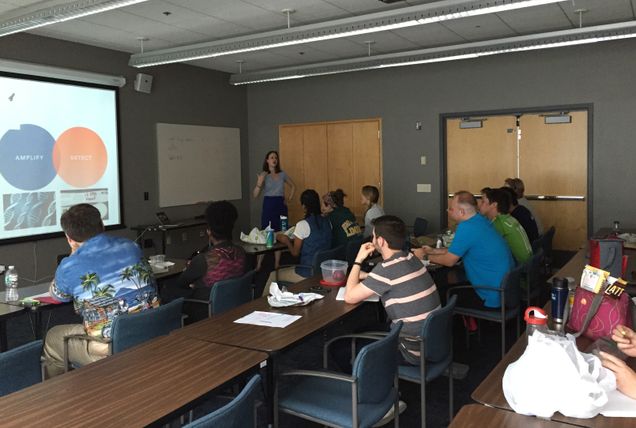 Biomedical, Materials Science and Mechanical Engineering. She provided interesting insight of how engineering disciplines are working with medical professionals to try to create point of care testing with more rapid diagnostics and simpler tests that will allow better treatment plans to those in need or at risk. She described the translational nature of the investigations and projects through the Future Technologies in Cancer Care. She taught about a particular focus for a point of care HIV test with a focused area of Nicaragua. The electronic communication from the lab and the doctors office, however the transport of sample from the doctor’s office to the central lab facility. Because of travel time, the samples would sometimes go bad arriving past the viability time of the sample. Prof. Klapperich’s students created a platform to extract the nucleic acids, dry them and position them in the diagnostic device, allowing a longer travel time for the samples to arrive at the central lab facility and still remain viable. One other important aspect of developing the process and technology is that the process must be able to run it without electricity. They are currently working with a company in Texas to create disposables for use in the field. One of our teachers asked, what about costs – and the need to drive down costs for new tests to make it desirable for adoption in the healthcare sector. Approvals are important before adoption to market.
Biomedical, Materials Science and Mechanical Engineering. She provided interesting insight of how engineering disciplines are working with medical professionals to try to create point of care testing with more rapid diagnostics and simpler tests that will allow better treatment plans to those in need or at risk. She described the translational nature of the investigations and projects through the Future Technologies in Cancer Care. She taught about a particular focus for a point of care HIV test with a focused area of Nicaragua. The electronic communication from the lab and the doctors office, however the transport of sample from the doctor’s office to the central lab facility. Because of travel time, the samples would sometimes go bad arriving past the viability time of the sample. Prof. Klapperich’s students created a platform to extract the nucleic acids, dry them and position them in the diagnostic device, allowing a longer travel time for the samples to arrive at the central lab facility and still remain viable. One other important aspect of developing the process and technology is that the process must be able to run it without electricity. They are currently working with a company in Texas to create disposables for use in the field. One of our teachers asked, what about costs – and the need to drive down costs for new tests to make it desirable for adoption in the healthcare sector. Approvals are important before adoption to market.
The biggest take away from Prof. Klapperich’s seminar is the understanding of the customer surroundings and the fact that engineering disciplines directly affect and have direct impact on society needs. What convinced Prof. Klapperich to pursue engineering? Watching cement dry in an environmental SEM in college, it was so interesting, she decided to take a risk and transfer to engineering to continue to make discoveries. She encourages the teachers to expose their students to active technology to engage their student to discover what engineering technology can show you!
Cleanroom Group 2, Metal Deposition and Lift-off, July 23, 2015
RET Forum Allows for Open Discussion with BU Faculty, July 23, 2015
The RET’s gathered this morning sitting opposite BU faculty, including Director of the Photonics Center, Thomas Bifano, and PI’s Bennett Goldberg, Helen Fawcett and Xin Zhang. The teachers were able to talk about their individual schools and how their districts deal with STEM education. They discussed how language and race play a role in the classroom, and how the teachers handle the challenges that present themselves with underrepresented minorities and economically disadvantaged youth in the academic setting. RET George DeGregorio, from East Boston High School, speaks of how ethnicity is not the only factor in the creation of a gap in his classes, but how the wide range of skill sets of his students also plays a role.
Cleanroom Group 1 – Metal Deposition and Lift-off, Wednesday, July 22, 2015
The first cleanroom group entered OPF after a week off from their first photolithography session. The teachers would be running the CHA metal deposition system and learned about adhesion layers of titanium that are first put down to help the gold stick to the silicon wafer. Then the teachers put down their gold layer on the wafers. During the pump down process, discussions centered around vacuum, pumping down from atmosphere and how to describe the units and scaling of low vacuum and high vacuum and the counterintuitive descriptions based upon vacuum levels. More importantly, as Brandon Van Leer pointed out in the FIB outreach sessions, human beings cannot live in the vacuum environment. Once completed with deposition, the teachers entered the other side of OPF to complete their lift off process. The pictures below show the process, where wafers are placed in an acetone and undergo an ultrasonic bath to assist in breaking through the gold coated photoresist layers. The end result leaves the teachers with wafers coated in gold and with silicon areas exposed. The more clear areas on the wafer, the more gold stays behind.
NSF Program Manager Garie Fordyce visits NSF RET INM site, July 20, 2015
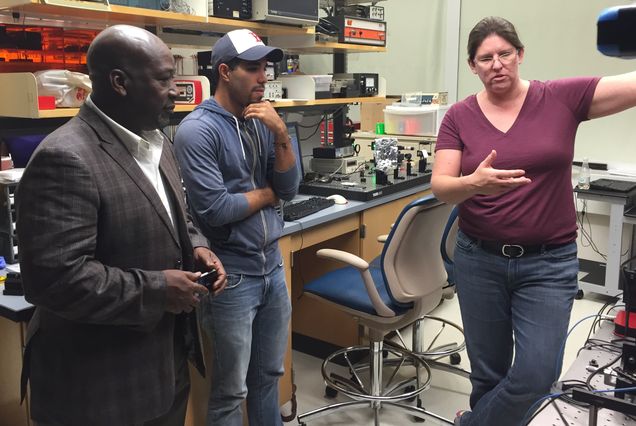 The team welcomed NSF Program Manager Garie Fordyce, who spent some time with us in the afternoon learning about the RET site and the participants. He was very impressed with our website and was happy to see an undergraduate in COM lending their expertise to an engineering site. Garie’s visit reinforced the need for the personal connection between the faculty and the teachers that would lead to continued collaboration between BU and participating local schools. In addition, he was very supportive of having our participating faculty and graduate mentors visit their mentored teacher classrooms. Having the vantage point of immersion into the classroom for a day will help BU’s faculty better understand the environment in which our public school teachers train the future engineers. After a discussion with the PI’s, Garie went to the labs to meet several of our RET participants. George and Jenn were able to explain to Garie their work in Prof. Bifano and Goldberg’s laboratories. As Jenn pointed out – “Rock Optics” is a great project where she can engage her classroom on multiple fronts when she relates her summer of looking into rocks and imaging what is behind the porous solid. Later, we visited Ryan in Prof. Dennis’ laboratory. Ryan countered and complemented Jake’s explanation of the quantum dot technology that they are exploring together demonstrating the collaborative and synergistic relationship between the REU and RET pairs. The team thanks Garie for visiting with us and providing feedback and advice for continuing to grow the program.
The team welcomed NSF Program Manager Garie Fordyce, who spent some time with us in the afternoon learning about the RET site and the participants. He was very impressed with our website and was happy to see an undergraduate in COM lending their expertise to an engineering site. Garie’s visit reinforced the need for the personal connection between the faculty and the teachers that would lead to continued collaboration between BU and participating local schools. In addition, he was very supportive of having our participating faculty and graduate mentors visit their mentored teacher classrooms. Having the vantage point of immersion into the classroom for a day will help BU’s faculty better understand the environment in which our public school teachers train the future engineers. After a discussion with the PI’s, Garie went to the labs to meet several of our RET participants. George and Jenn were able to explain to Garie their work in Prof. Bifano and Goldberg’s laboratories. As Jenn pointed out – “Rock Optics” is a great project where she can engage her classroom on multiple fronts when she relates her summer of looking into rocks and imaging what is behind the porous solid. Later, we visited Ryan in Prof. Dennis’ laboratory. Ryan countered and complemented Jake’s explanation of the quantum dot technology that they are exploring together demonstrating the collaborative and synergistic relationship between the REU and RET pairs. The team thanks Garie for visiting with us and providing feedback and advice for continuing to grow the program.
FEI Outreach – July 16, 2015, Brandon Van Leer
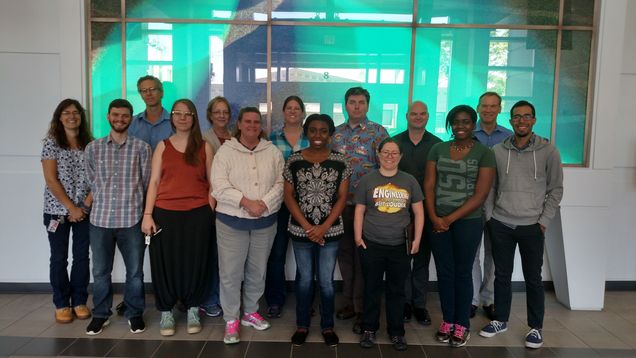
Brown Bag Seminar – Introduction to Photonics, July 15, 2015 Prof. Roberto Paiella
Professor Roberto Paiella engaged our undergraduates in a discussion on Introduction to Photonics. Prof. Paiella is Lauren Strong’s PI this summer and we were thrilled to have him address our REU and RET participants. We learned about optical engineering and careers and applications of photonics. We covered the basics of what is light, what are the properties of light, how do we create it and finally what can we do with it?
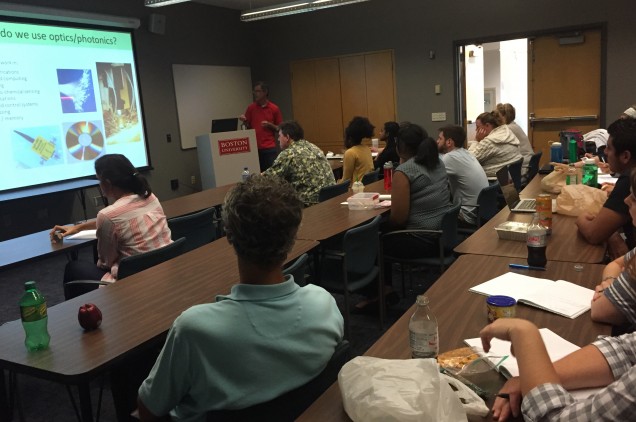 Professor Paiella brought a fundamental question to the group: how are the properties of light affected by their environment? We had to first understand that if you take two waves interfering, the resultant wave could be larger or smaller depending on the waves and their phase difference. A soap bubble example was given to the group to remind them of the colors you see result from the interference between the ambient light and the thin film (soap bubble). The light reflects off the surface of the bubble, goes through the film and also reflecting back from the surface. It is a great example of constructive and destructive interference as a result of film thickness differences as you go around the bubble surface. We also learned about diffraction and the way to draw parallels between light and water waves. In discussions, we determined that this is a great way for our teachers to enforce the fact that light is made up of waves (and particles) and has the properties similar to liquid waves. Using a water wave table and getting some diffraction slits, these two concepts of wave propagation can be demonstrated in the classroom. Lasers were invented in the 1960’s and it was clear that they were an interesting technology – a lot of the applications we have today have developed from laser technology. The biggest application for lasers was weapons – coming from the Star Wars defense initiative.
Professor Paiella brought a fundamental question to the group: how are the properties of light affected by their environment? We had to first understand that if you take two waves interfering, the resultant wave could be larger or smaller depending on the waves and their phase difference. A soap bubble example was given to the group to remind them of the colors you see result from the interference between the ambient light and the thin film (soap bubble). The light reflects off the surface of the bubble, goes through the film and also reflecting back from the surface. It is a great example of constructive and destructive interference as a result of film thickness differences as you go around the bubble surface. We also learned about diffraction and the way to draw parallels between light and water waves. In discussions, we determined that this is a great way for our teachers to enforce the fact that light is made up of waves (and particles) and has the properties similar to liquid waves. Using a water wave table and getting some diffraction slits, these two concepts of wave propagation can be demonstrated in the classroom. Lasers were invented in the 1960’s and it was clear that they were an interesting technology – a lot of the applications we have today have developed from laser technology. The biggest application for lasers was weapons – coming from the Star Wars defense initiative.
FEI’s Outreach – July 14, 2015 – Brandon Van Leer’s microscopy seminar
Brandon Van Leer, Business Development & Product Marketing Engineer from FEI in Hillsboro, OR arrived at Boston University Photonics Center on Tuesday, July 14. He spent some time on the instrument with FIB/TEM Facility (FTF) Laboratory Manager, Alexey Nikiforov, preparing for FIB workshops on Wednesday and Thursday morning. Brandon gave an overview of FEI as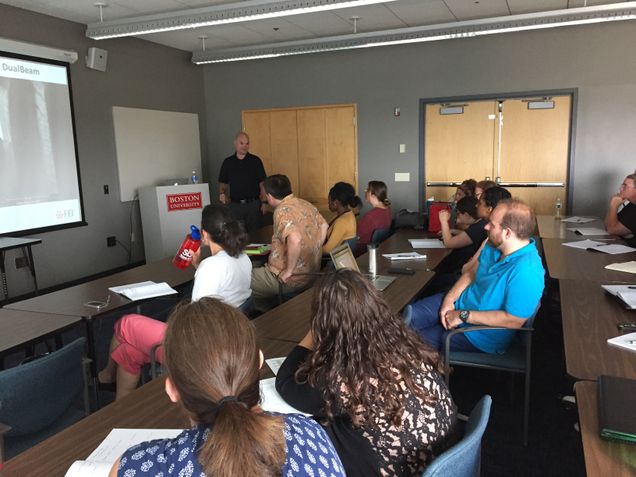 a company and the exciting applications utilizing a Focused Ion Beam (FIB) system this afternoon, describing beam parameters, how the FIB works and what types of structures can be fabricated in the system. Over the next two days, Brandon will work directly with our teachers to help them understand the instrument capabilities and the applications of the tool to nanotechnology. We wanted to thank you to FEI for providing this phenomenal outreach to our undergraduates and teachers.
a company and the exciting applications utilizing a Focused Ion Beam (FIB) system this afternoon, describing beam parameters, how the FIB works and what types of structures can be fabricated in the system. Over the next two days, Brandon will work directly with our teachers to help them understand the instrument capabilities and the applications of the tool to nanotechnology. We wanted to thank you to FEI for providing this phenomenal outreach to our undergraduates and teachers.
This morning in the cleanroom – Group 2 – July 9, 2015
Our Communications Intern, Emily Biehl (COM 17), joined several of our teachers this morning to dive into the Cleanroom Experience alongside the teachers. Once again, the teachers created their own masks that they would use to expose the photoresist and then develop in preparation for metal deposition and lift off. Out of her element? We think not, Emily showed great form in the cleanroom and started a new trend for photoresist deposition that all the teachers agreed was the best method for deposition on their wafers. Below are some highlights from this group’s cleanroom experience.
Brown Bag Seminar – July 8, 2015 – Nanoscribe and Nanotechnology
The RET participants attended their first brown bag seminar today with Charles Lissandrello, former BU graduate student from Professor Kamil Ekinci’s Lab and a current postdoctoral researcher in Professor Alice White’s Multiscale Laser Lithography Lab – ML^3, leading the discussion. Charlie spent some time with the REU and RET participants describing how the Nanoscribe instrument in their laboratory works and how to generate Nanoscribe designs to ensure appropriate structures are chosen for writing. Our teachers will have an opportunity to work directly with Charlie to prepare their 3-D nanoscale devices at the end of the month. This fascinating technology generated lots of questions on how the structures are made and how the exposures are done. Teachers will spend a session using the Scanning Electron Microscope to generate micrographs of their devices that will enable their middle and high school students to see what this tiny cube holds.
Following Charlie’s discussion on the Nanoscribe, Professor Helen Fawcett engaged the student and teacher participants in a flipped presentation where they generated answers to what is a nanometer, what is nanotechnology and more importantly, how did they define what Integrated Nanomanufacturing actually means. In the open discussion undergraduates and teachers talked together about how to envision and describe the nanoscale for themselves and their students.
This morning in the Clean Room… – July 8, 2015
The first group of teachers entered the cleanroom today and went straight into the Class 100 (100 particles per cubic meter) Photolithgraphy room, also know as the yellow room. There are sleeves that are the bulbs that filter out wavelengths that would expose the resist. Our teachers learned how to program a Headway Photoresist Spinner, how to set up the MA6 for exposures. The teachers worked together to figure out the optimal method for adding resist to the wafers and were inspired by seeing their masks reprinted on the wafers.
Did You Know?
Teachers’ Participation in Research Programs Improves Their Students’ Achievement in Science
Take a Look!
And We’re Off…RET’s first day – July 6, 2015
Research Experiences for Teachers is aimed at providing faculty from local middle, high schools and community colleges the background they need to incorporate STEM curriculum into their classrooms. Here at BU Photonics, we want these teachers to be well equipped to shape the minds of future engineers and scientists.
This morning was the RET Introductory Day. Each teacher shared their goals for the program, with co-directors Prof. Bennett Goldberg and Prof. Helen Fawcett. They also shared what they hoped to gain out of their experience at BU over the next six weeks. Most indicated personal curiosity and a desire to expand their knowledge of engineering and technology. That curiosity will inspire their students to be curious once they are back in the classrooms this fall. One of 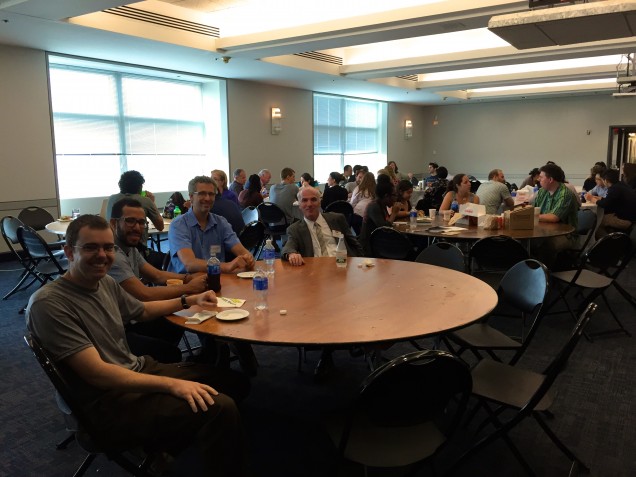 our RET’s, Eric Jackson, a Physics and Biology teacher at Dracut High School, is a coach for the Jr. Engineering and Technology Society (JETS) and wants the ability to work more efficiently with new technology so that he can keep his students updated and skilled with the newest innovations. Another general point raised by the teachers was finding ways to encourage females into the advanced math and science classes and ultimately into engineering. Amanda Dillingham told us that her female students were surprised that she ventured into the RET program. Ultimately, teachers who are “pushing their limits” will inspire their students to do the same.
our RET’s, Eric Jackson, a Physics and Biology teacher at Dracut High School, is a coach for the Jr. Engineering and Technology Society (JETS) and wants the ability to work more efficiently with new technology so that he can keep his students updated and skilled with the newest innovations. Another general point raised by the teachers was finding ways to encourage females into the advanced math and science classes and ultimately into engineering. Amanda Dillingham told us that her female students were surprised that she ventured into the RET program. Ultimately, teachers who are “pushing their limits” will inspire their students to do the same.
Jennifer Wozniak, from Rockland High School, wants to keep her brain sharp and stay updated in the industry. Jenn teaches AP Physics, robotics and has taught courses in engineering through a program via the University of Texas in Austin.
After the RETs were trained in lab, laser and OPF safety, they watched as the REU’s shared their experiences thus far in the program, where they came fro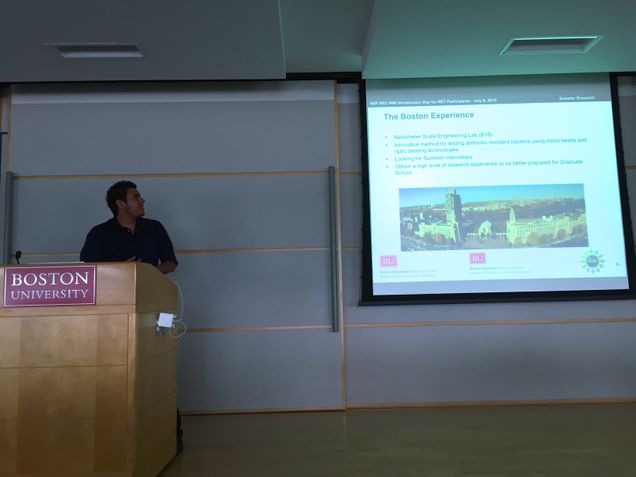 m and what lead them here to BU for a summer research experience. They discussed the work they have done in the lab so far, where they are heading in their research, and how their experience with their mentors has been. The RETs listened closely because soon, they themselves will be conducting research in the lab and be mentored by some of the best engineers in their fields. The next few weeks will be filled with research and discovery that will soon make its way to the middle and high school classrooms all over Massachusetts and into the minds of the young engineers of tomorrow.
m and what lead them here to BU for a summer research experience. They discussed the work they have done in the lab so far, where they are heading in their research, and how their experience with their mentors has been. The RETs listened closely because soon, they themselves will be conducting research in the lab and be mentored by some of the best engineers in their fields. The next few weeks will be filled with research and discovery that will soon make its way to the middle and high school classrooms all over Massachusetts and into the minds of the young engineers of tomorrow.








































